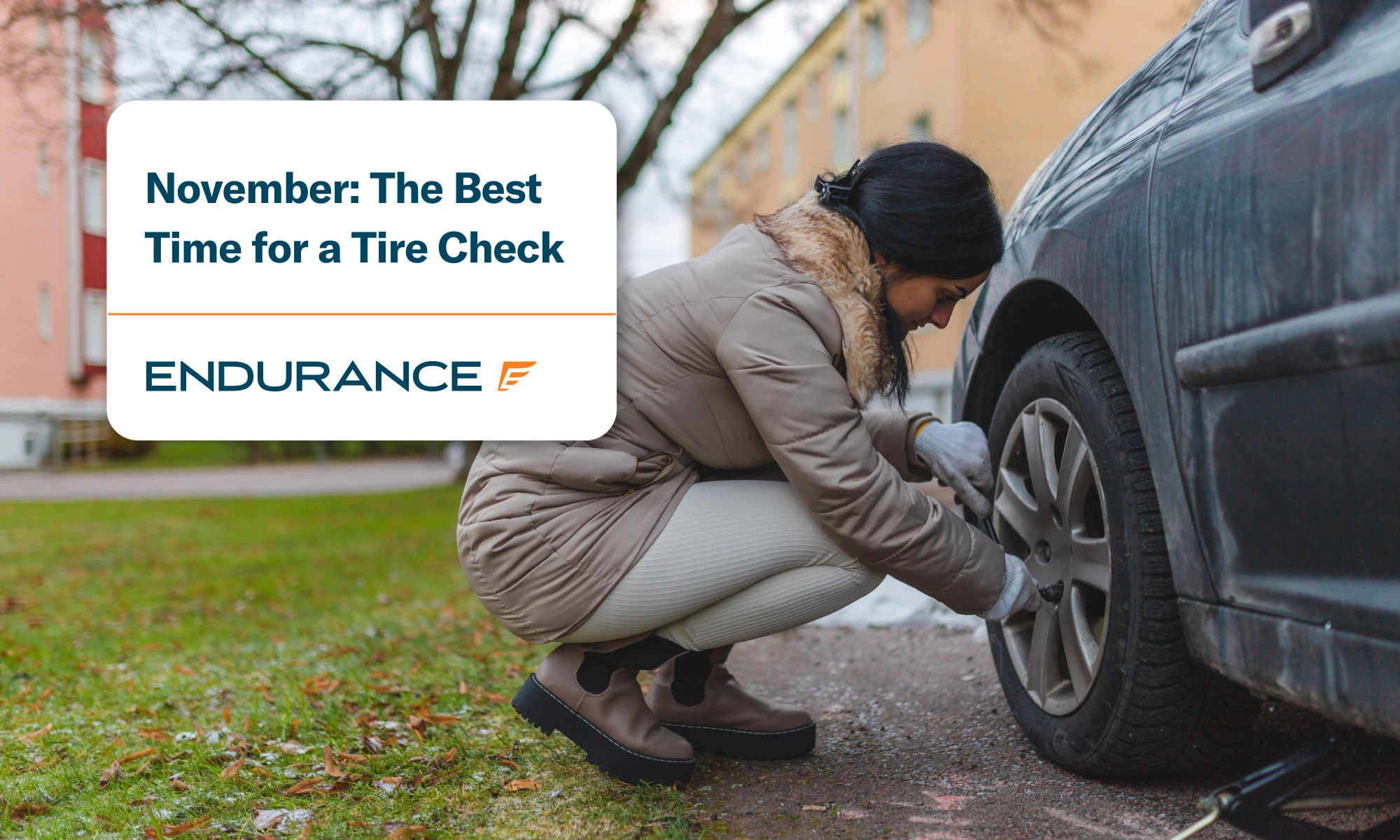Get this deal! Call now.
Speak with a vehicle protection plan specialist and get $300 off any new contract instantly.
Call 866-678-4172
or scan the code below


November welcomes the holiday season, so distractions are understandable. However, not staying on top of your car’s maintenance can lead to trouble in the coming months. This diligence is especially critical with tires, as slippery roads may come faster than expected. At the same time, temperatures drop, tire pressure decreases, rubber stiffens, and traction declines.
Basic checks like inspecting the treads, investigating wear, or researching a new tire purchase can keep you safe before winter takes hold. In addition, acting now avoids December’s crunch time when everyone is planning holiday travel. Keep reading as we explain why November is the best time to get your car’s tires winter-ready.
Tire performance and temperature are directly connected. For every 10°F drop, air pressure falls by 1-2 PSI, which can cause under-inflation and compromised handling. To put these numbers in a real-world perspective, the U.S. Department of Energy reports that fuel economy (or fuel efficiency) drops by about 0.2% for every 1 PSI reduction of average tire pressure. The National Highway Traffic Safety Administration (NHTSA) offers more sober statistics about the importance of tire upkeep and having the right tires. Each year, there are almost 11,000 tire-related motor vehicle accidents in the U.S., leading to over 600 fatalities annually.
Beyond these impactful numbers, colder temperatures have other impacts. Primarily, the rubber compounds in all-season tires stiffen below 45°F, which affects grip on the road surface. Traction reduces, and braking distances increase. Thanks to specially formulated rubber, winter tires can help in climates where temperatures consistently stay below this threshold.
Should you opt for replacements, winter tire change timing favors November. You’ll stay ahead of the seasonal rush and might get lucky with an early Black Friday tire deal. Also, milder weather enables tire technicians to better focus on your car.
A tire’s tread is integral to tackling rain, ice, and slush. Once the tread depth reaches 4/32-inch, winter traction is compromised. If it drops below 2/32-inch, the law in most states says it’s time for new tires. A basic tire tread depth test involves inserting an upside-down penny between the treads. If Lincoln’s head is visible, the tires need replacing. See the “Pro Tip” below for checking tires with a specialized but simple gauge.
Here’s a breakdown of common tire tread issues and their causes. Staying ahead of these issues can delay the need for new tires.
| Tread Issue | Cause |
| Center Wear | Over-inflation |
| Edge Wear | Under-inflation |
| One-sided wear | Alignment problems |
| Cupping or Scalloping | Suspension or balance trouble |
| Feathering | Wheel misalignment |
A thorough DIY inspection involves checking the tire sidewall for bulges, cuts, or cracks. Even minor damage in this area can affect tire safety. If you spot uneven tread wear, have the underlying cause confirmed by an experienced technician before spending money on replacements.
While the penny test is helpful, a tire gauge can be invaluable. It’s an easy-to-use device that costs about $10 and provides precise tread depth readings. Follow these steps for a more complete look at tread health:
The winter tires vs all-season debate can be decided by where you drive. All-season tires do well in most conditions, including moderate winters with occasional snow or icy conditions. However, winter tires provide a clear advantage when temperatures stay consistently below 45°F and roads are more likely to stay slick.
Deeper grooves and flexible compounds improve braking on snow and ice. In testing, Tire Rack showed that vehicles with studless winter tires traveling at 10 mph stopped in about 21 feet, compared to almost 40 feet for cars with all-season tires. Winter tires also deliver improved cornering stability and traction on cold, slick pavement.
Do you need winter tires? Consider these elements to determine what works best:
| Winter Climate | Does your region experience frequent snow or freezing rain? |
| Driving Routes | Do you drive on roads that aren’t fully cleared after winter precipitation? |
| Vehicle Type | While all-wheel drive (and front-wheel drive, to a lesser extent) helps with acceleration, this capability does little to support stopping or steering in snow. Winter tires help with all three. |
| Budget | Quality winter tires will cost $150 to $300 each, plus mounting fees. However, depending on where you live, they’re only used for four to six months out of the year. |
An illuminated tire-pressure light is nothing unusual in November. A TPMS warning in cold weather usually means a tire is low on air due to natural pressure loss rather than a puncture. Cool temperatures cause air to contract, resulting in a loss of tire pressure. In most cars, the dashboard warning light illuminates when the level drops below 25% of normal.
When tire pressure drops cold, it’s usually just physics; don’t panic. Just check the level and top off with extra air. Verify the correct tire pressure level by looking at the driver’s door or door jamb sticker. Then, inflate the tire accordingly. It’s always a good idea to double-check tire pressure after a few days to ensure there isn’t a slow leak.
Keep these cold-weather inflation tips in mind:
A more complete approach to tire maintenance includes staying on top of balancing and alignments. A balanced wheel-and-tire assembly improves ride comfort by minimizing vibration. It’s a simple adjustment that most repair shops and tire retailers can handle and is especially vital with winter tires.
Alignments are also essential to ensure the tires contact the road at the correct angles. If this doesn’t happen, the tires can wear unevenly, and the car may drift. AAA recommends checking the alignment annually, after striking a pothole or curb, or if there’s a change in handling.
A thorough maintenance program includes setting a tire rotation schedule, which can coincide with oil changes (about every 5,000 to 7,500 miles). Swapping tire positions helps distribute wear more evenly, extending longevity.
There are two ways of handling seasonal tires: swapping the sets between one set of wheels or having dedicated wheels for each set of tires. One approach isn’t better than the other; it comes down to convenience and cost. Using one set of wheels means paying for mounting and balancing each time you switch. A second set costs more upfront, but eliminates those recurring charges. If you’re a DIYer, you can handle the seasonal swap yourself, though it’s still smart to have a professional check the balance and alignment afterward.
Regardless of your setup, here are tire storage tips to follow:
Alternatively, some shops will professionally store your tires for $50-$100 per season.
Holiday travel car prep goes beyond tires by looking at these other key systems before hitting cold or icy roads.
Along with these checks, perform scheduled maintenance tasks (like an oil and filter change) to ensure your car is ready for holiday driving. As with all vehicle maintenance and repairs, keep the receipts to document the work, which may be required if you have a vehicle service contract or extended car warranty.
Cold weather can cause uncertainty among car owners, especially those with older vehicles no longer protected by a factory warranty. An Endurance Warranty plan (also called an extended warranty or auto protection plan) safeguards against breakdowns and unexpected repair bills.
Every Endurance plan includes 24/7 roadside assistance with towing, rental car support, trip interruption protection, and the freedom to choose any licensed repair facility for covered repairs. Customers are also eligible for a year of Elite Benefits with tire replacement coverage, windshield repair, key fob replacement, and more.*
Learn about everything an Endurance auto protection plan offers. Request a FREE quote or visit our online store to see your price and plan recommendations now. Endurance plan advisors are also available by phone at (800) 253-8203.
Read the Endurance blog to learn more about warranties, DIY maintenance, repair advice, vehicle reviews, and more.

We've received your vehicle information and will contact you shortly with your quote.
— OR —
Start shopping for a coverage plan now.

We're here to make sure you get the most comprehensive EV protection. That's why we've partnered with Xcelerate Auto to offer you transparent and dependable Tesla coverage.
Want us to contact you about XCare coverage for your Tesla?



Your protection is our top priority. Your quote is in progress and you will
receive a confirmation
email shortly.


Speak with a vehicle protection plan specialist and get $300 off any new contract instantly.

Call for $300 off any new plan!
By clicking the button, you consent to Endurance using automated technology to call, email, and text you using the contact info above, including your wireless number, if provided, regarding auto protection or, in California, mechanical breakdown insurance. You also agree to the Endurance Privacy Policy and Terms and Conditions. Consent is not a condition of purchase, and you can withdraw consent at any time. Message and data rates may apply.


Speak with a vehicle protection plan specialist and get $300 off any new contract instantly.
Call 866-678-4172
or scan the code below



Simply fill out the information below and we will follow up fast with your free no-obligation quote.
By clicking the button, you consent to Endurance using automated technology to call, email, and text you using the contact info above, including your wireless number, if provided, regarding auto protection or, in California, mechanical breakdown insurance. You also agree to the Endurance Privacy Policy and Terms and Conditions. Consent is not a condition of purchase, and you can withdraw consent at any time. Message and data rates may apply.

To speak to a vehicle protection plan specialist and get $300 off any new contract instantly
Scan the code below
Dave is an automotive journalist combining a deep passion for cars, hands-on mechanical experience, and dealership insight. His writing primarily focuses on consumer auto advice and enthusiast pieces. A regular contributor to SlashGear.com and other leading automotive platforms, Dave earned his BA in Journalism from The George Washington University.